Abstract
We have found immunoglobulin (Ig) G-containing material consistent with immune complexes in the sera of patients with Lyme arthritis. It was detected in 29 of 55 sera (55%) from 31 patients by at least one of three assays: 125I-C1q binding, C1q solid phase, or Raji cell. The presence of reactive material correlated with clinical aspects of disease activity; it was found early in the illness, was most prominent in sera from the sickest patients, was infrequent during remissions, and often fluctuated in parallel with changes in clinical status. The results in the two C1q assays showed a strong positive correlation (P<0.001). They were each elevated in 45% of the sera and were usually concordant (85%). In contrast, the Raji cell assay was less frequently positive and often discordant with the C1q assays. In sucrose density gradients, putative circulating immune complexes sedimented near 19S; they, too, were detected best by the two assays based on C1q binding. An additional 7S component was found in some sera by the 125I-C1q binding assay. Serum complement was often above the range of normal in patients with mild disease and normal in patients with severe disease but did not correlate significantly with levels of circulating immune complexes. IgM and IgG rheumatoid factors were not detectable.
These findings support a role for immune complexes in the pathogenesis of Lyme arthritis. Their measurement, by either the 125I-C1q binding assay or by the C1q solid phase assay, often provides a sensitive index of disease activity. Moreover, the complexes are likely sources of disease-related antigens for further study of this new disorder.
Full text
PDF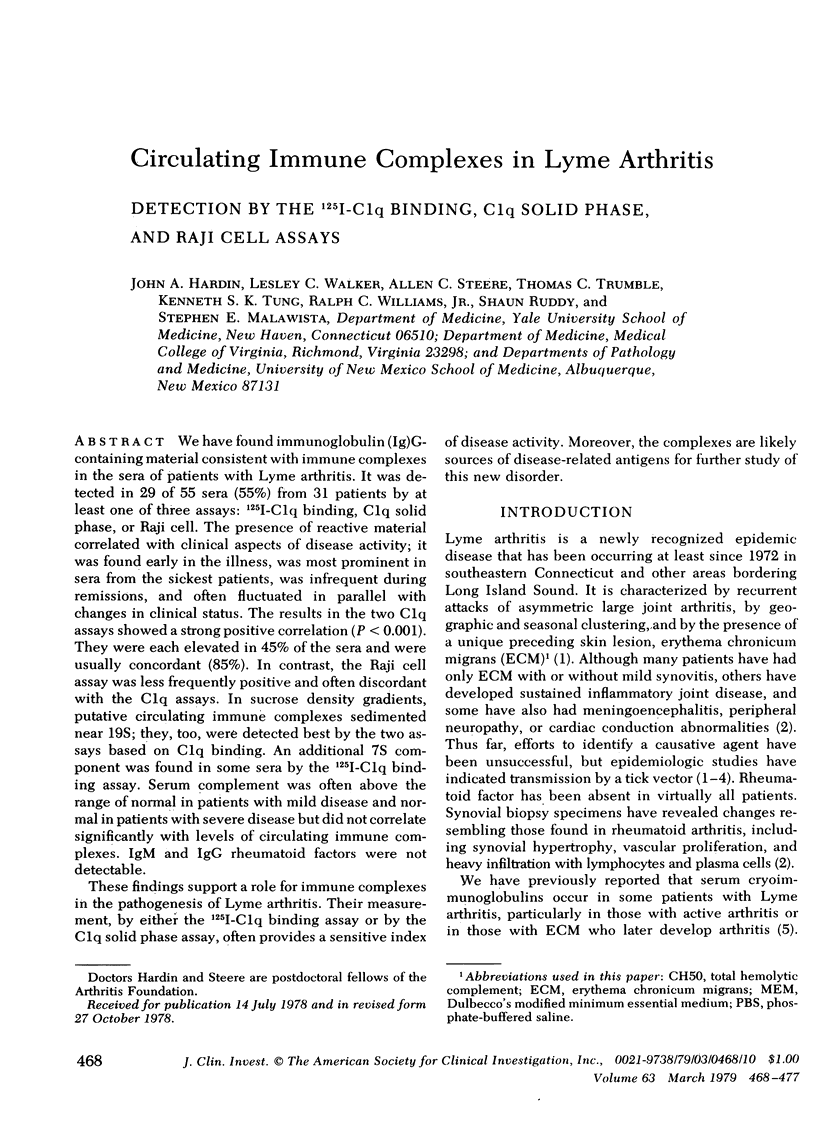
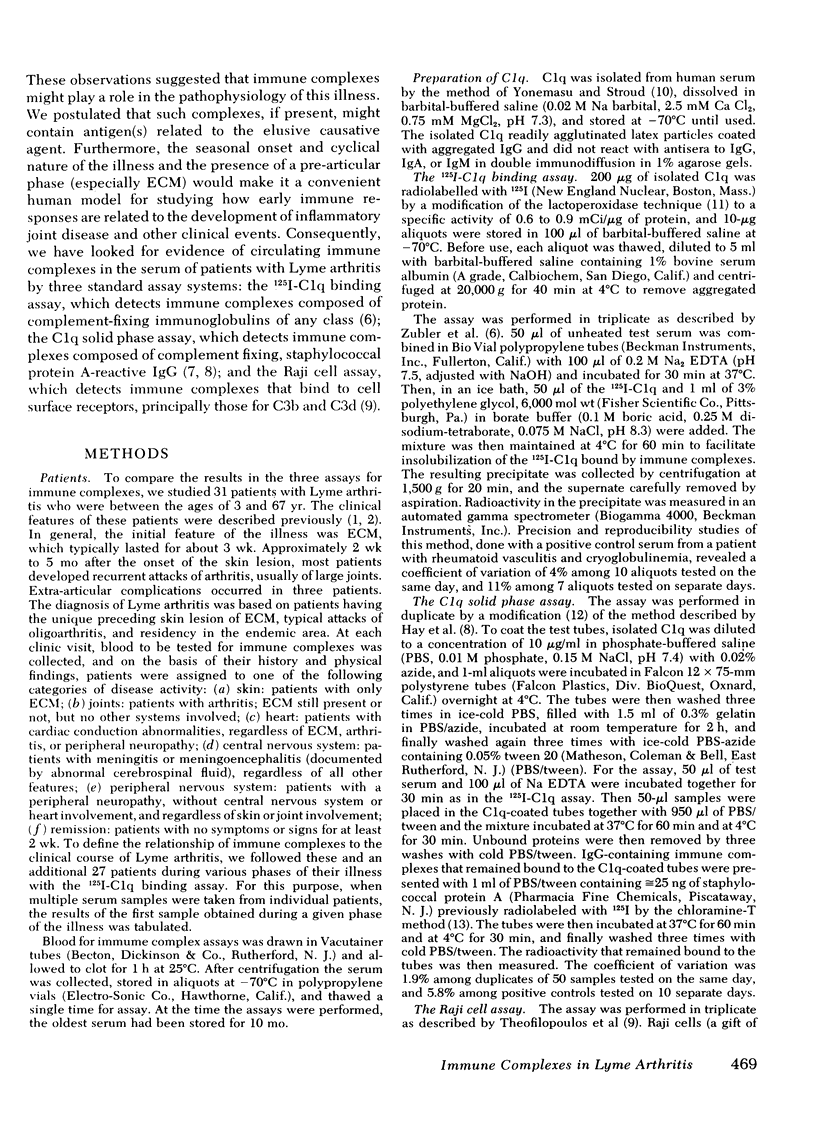
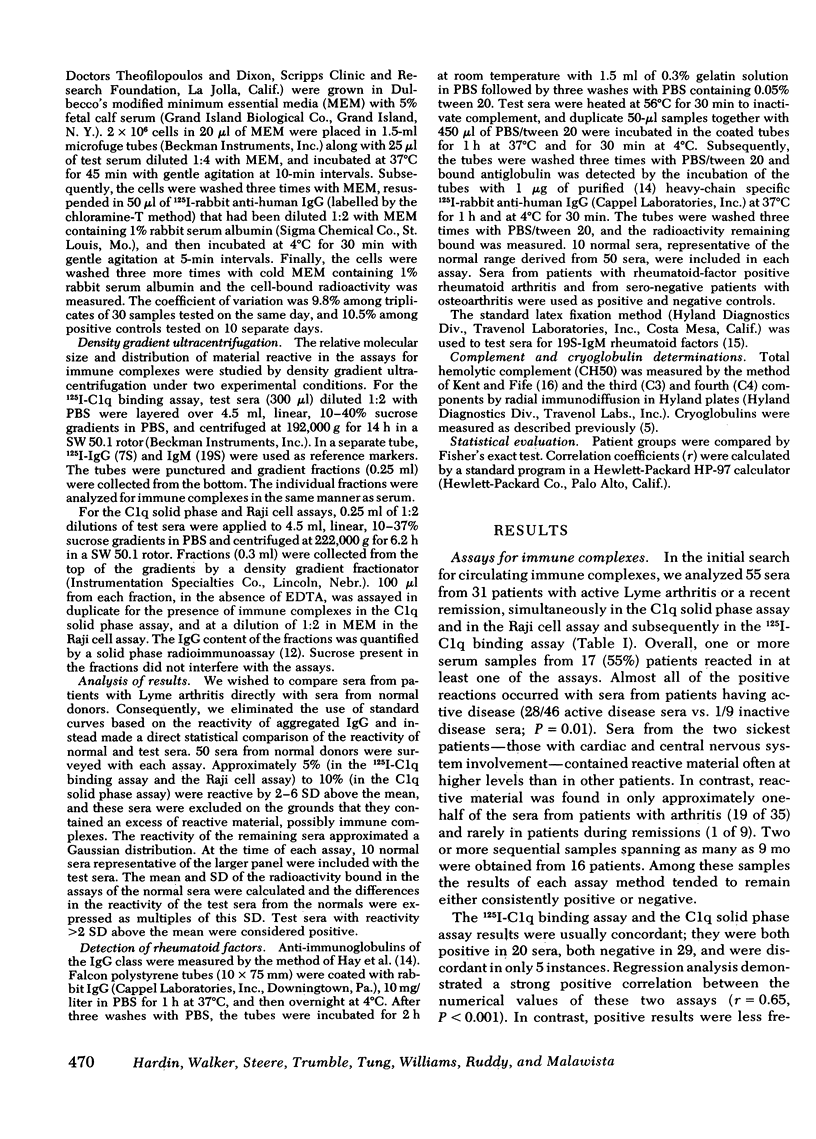
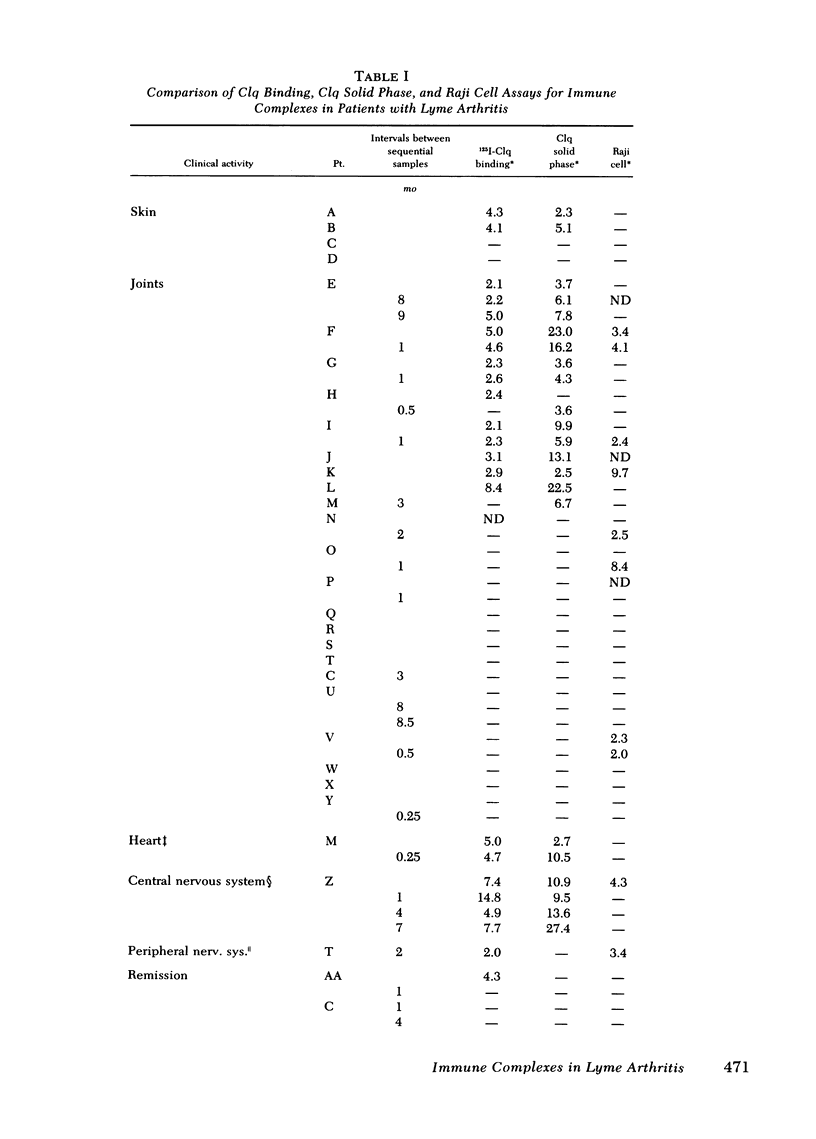
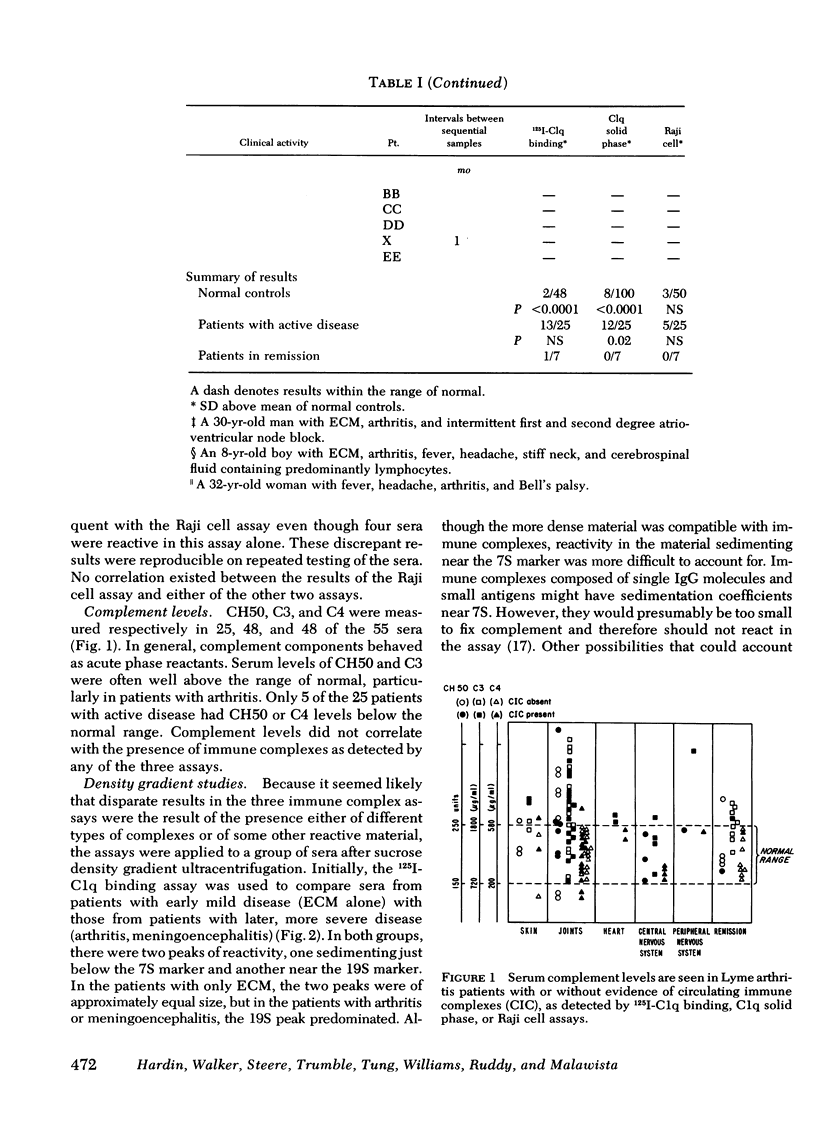
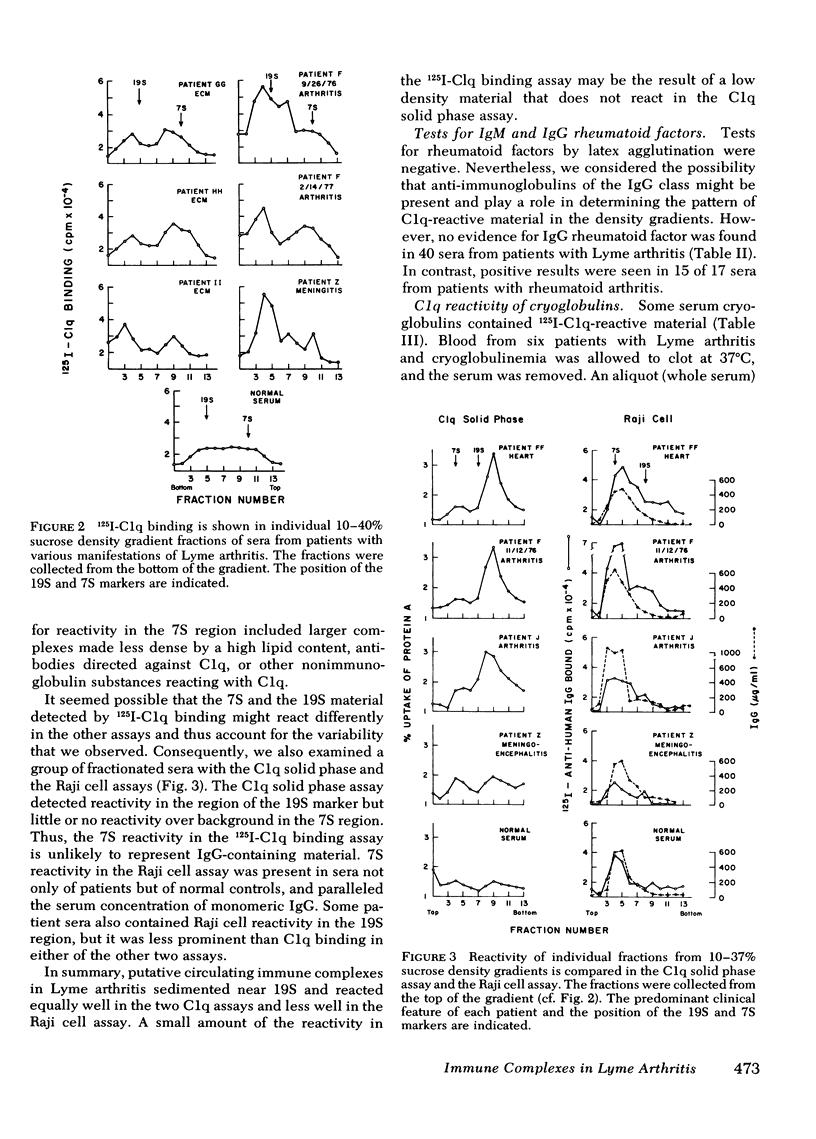
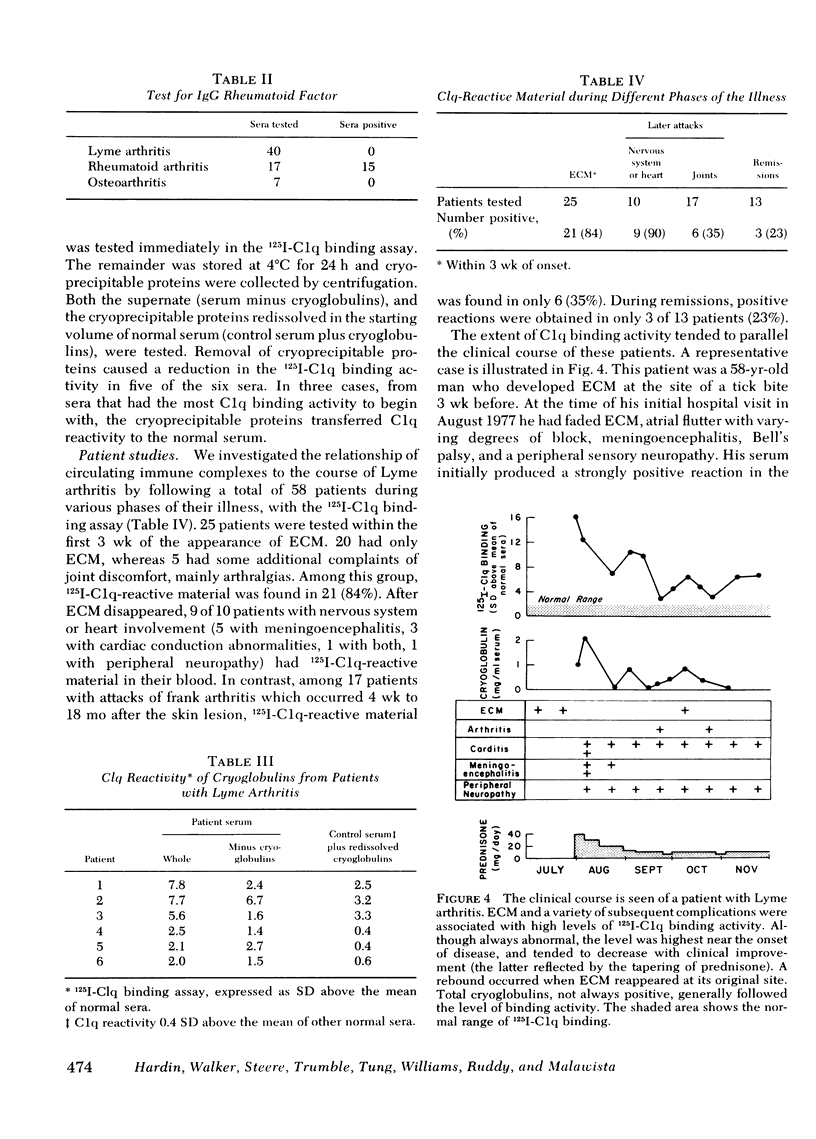
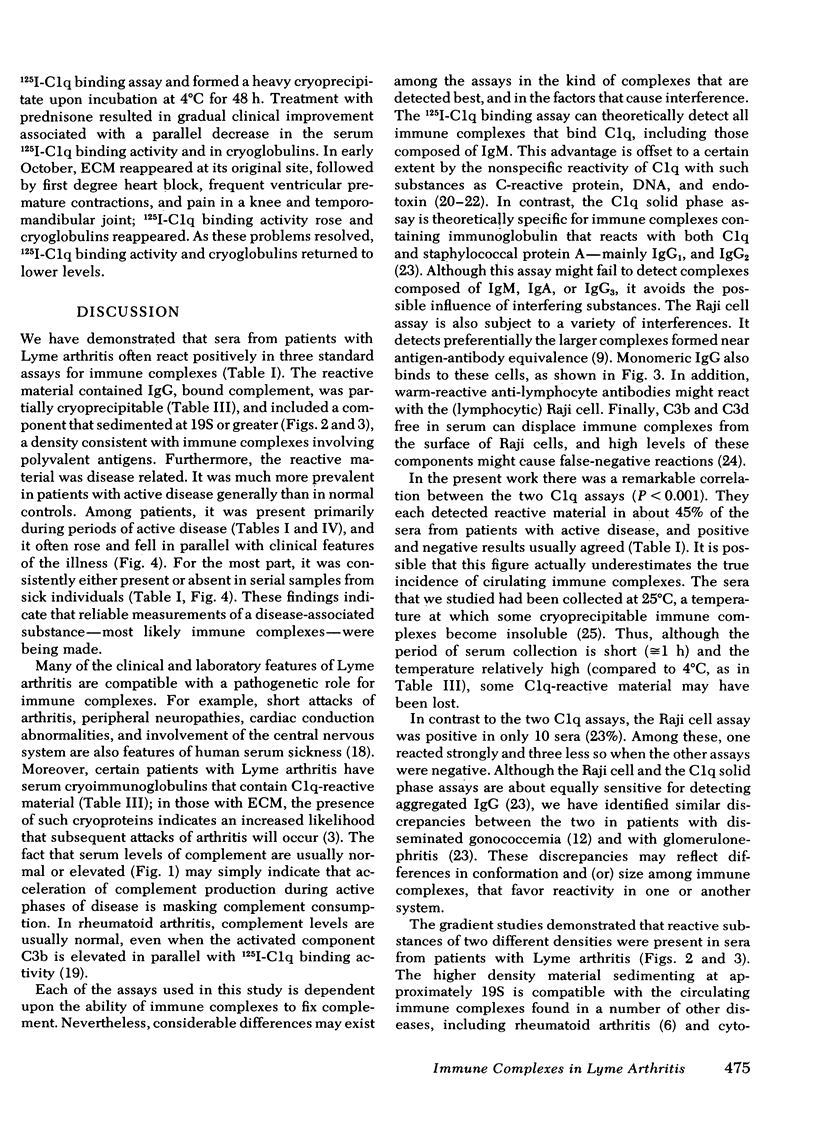
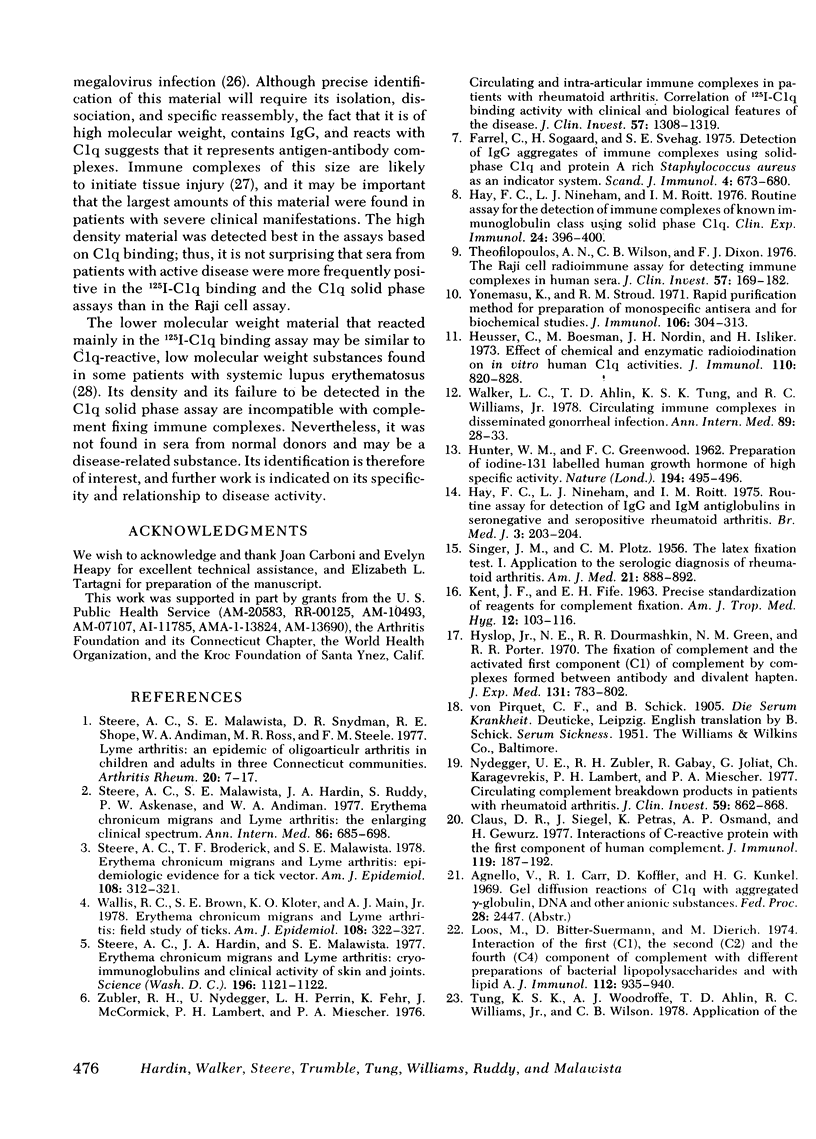

Selected References
These references are in PubMed. This may not be the complete list of references from this article.
- Claus D. R., Siegel J., Petras K., Osmand A. P., Gewurz H. Interactions of C-reactive protein with the first component of human complement. J Immunol. 1977 Jul;119(1):187–192. [PubMed] [Google Scholar]
- Cochrane C. G., Hawkins D. Studies on circulating immune complexes. 3. Factors governing the ability of circulating complexes to localize in blood vessels. J Exp Med. 1968 Jan 1;127(1):137–154. doi: 10.1084/jem.127.1.137. [DOI] [PMC free article] [PubMed] [Google Scholar]
- Farrell C., Sogaard H., Svehag S. E. Detection of IgG aggregates or immune complexes using solid-phase C1q and protein A-rich Staphylococcus aureus as an indicator system. Scand J Immunol. 1975;4(7):673–680. doi: 10.1111/j.1365-3083.1975.tb02675.x. [DOI] [PubMed] [Google Scholar]
- Gabriel A., Jr, Agnello V. Detection of immune complexes. The use of radioimmunoassays with Clq and monoclonal rheumatoid factor. J Clin Invest. 1977 May;59(5):990–1001. doi: 10.1172/JCI108722. [DOI] [PMC free article] [PubMed] [Google Scholar]
- HUNTER W. M., GREENWOOD F. C. Preparation of iodine-131 labelled human growth hormone of high specific activity. Nature. 1962 May 5;194:495–496. doi: 10.1038/194495a0. [DOI] [PubMed] [Google Scholar]
- Hay F. C., Nineham L. J., Roitt I. M. Routine assay for detection of IgG and IgM antiglobulins in seronegative and seropositive rheumatoid arthritis. Br Med J. 1975 Jul 26;3(5977):203–204. doi: 10.1136/bmj.3.5977.203. [DOI] [PMC free article] [PubMed] [Google Scholar]
- Hay F. C., Nineham L. J., Roitt I. M. Routine assay for the detection of immune complexes of known immunoglobulin class using solid phase C1q. Clin Exp Immunol. 1976 Jun;24(3):396–400. [PMC free article] [PubMed] [Google Scholar]
- Heusser C., Boesman M., Nordin J. H., Isliker H. Effect of chemical and enzymatic radioiodination on in vitro human Clq activities. J Immunol. 1973 Mar;110(3):820–828. [PubMed] [Google Scholar]
- Hyslop N. E., Jr, Dourmashkin R. R., Green N. M., Porter R. R. The fixation of complement and the activated first component (C1) of complement by complexes formed between antibody and divalent hapten. J Exp Med. 1970 Apr 1;131(4):783–802. doi: 10.1084/jem.131.4.783. [DOI] [PMC free article] [PubMed] [Google Scholar]
- KENT J. F., FIFE E. H., Jr Precise standardization of reagents for complement fixation. Am J Trop Med Hyg. 1963 Jan;12:103–116. doi: 10.4269/ajtmh.1963.12.103. [DOI] [PubMed] [Google Scholar]
- Loos M., Bitter-Suermann D., Dierich M. Interaction of the first (C1), the second (C2) and the fourth (C4) component of complement with different preparations of bacterial lipopolysaccharides and with lipid A. J Immunol. 1974 Mar;112(3):935–940. [PubMed] [Google Scholar]
- Nydegger U. E., Zubler R. H., Gabay R., Joliat G., Karagevrekis C. H., Lambert P. H., Miescher P. A. Circulating complement breakdown products in patients with rheumatoid arthritis. Correlation between plasma C3d, circulating immune complexes, and clinical activity. J Clin Invest. 1977 May;59(5):862–868. doi: 10.1172/JCI108708. [DOI] [PMC free article] [PubMed] [Google Scholar]
- PLOTZ C. M., SINGER J. M. The latex fixation test. I. Application to the serologic diagnosis of rheumatoid arthritis. Am J Med. 1956 Dec;21(6):888–892. [PubMed] [Google Scholar]
- Stagno S., Volanakis J. E., Reynolds D. W., Stroud R., Alford C. A. Immune complexes in congenital and natal cytomegalovirus infections of man. J Clin Invest. 1977 Oct;60(4):838–845. doi: 10.1172/JCI108838. [DOI] [PMC free article] [PubMed] [Google Scholar]
- Steere A. C., Broderick T. F., Malawista S. E. Erythema chronicum migrans and Lyme arthritis: epidemiologic evidence for a tick vector. Am J Epidemiol. 1978 Oct;108(4):312–321. doi: 10.1093/oxfordjournals.aje.a112625. [DOI] [PubMed] [Google Scholar]
- Steere A. C., Hardin J. A., Malawista S. E. Erythema chronicum migrans and Lyme arthritis: cryoimmunoglobulins and clinical activity of skin and joints. Science. 1977 Jun 3;196(4294):1121–1122. doi: 10.1126/science.870973. [DOI] [PubMed] [Google Scholar]
- Steere A. C., Malawista S. E., Hardin J. A., Ruddy S., Askenase W., Andiman W. A. Erythema chronicum migrans and Lyme arthritis. The enlarging clinical spectrum. Ann Intern Med. 1977 Jun;86(6):685–698. doi: 10.7326/0003-4819-86-6-685. [DOI] [PubMed] [Google Scholar]
- Steere A. C., Malawista S. E., Snydman D. R., Shope R. E., Andiman W. A., Ross M. R., Steele F. M. Lyme arthritis: an epidemic of oligoarticular arthritis in children and adults in three connecticut communities. Arthritis Rheum. 1977 Jan-Feb;20(1):7–17. doi: 10.1002/art.1780200102. [DOI] [PubMed] [Google Scholar]
- Theofilopoulos A. N., Dixon F. J., Bokisch V. A. Binding of soluble immune complexes to human lymphoblastoid cells. I. Characterization of receptors for IgG Fc and complement and description of the binding mechanism. J Exp Med. 1974 Oct 1;140(4):877–894. doi: 10.1084/jem.140.4.877. [DOI] [PMC free article] [PubMed] [Google Scholar]
- Theofilopoulos A. N., Wilson C. B., Dixon F. J. The Raji cell radioimmune assay for detecting immune complexes in human sera. J Clin Invest. 1976 Jan;57(1):169–182. doi: 10.1172/JCI108257. [DOI] [PMC free article] [PubMed] [Google Scholar]
- Tung K. S., Woodroffe A. J., Ahlin T. D., Williams R. C., Jr, Wilson C. B. Application of the solid phase C1q and Raji cell radioimmune assays for the detection of circulating immune complexes in glomerulonephritis. J Clin Invest. 1978 Jul;62(1):61–72. doi: 10.1172/JCI109115. [DOI] [PMC free article] [PubMed] [Google Scholar]
- Walker L. C., Ahlin T. D., Tung K. S., Williams R. C., Jr Circulating immune complexes in disseminated gonorrheal infection. Ann Intern Med. 1978 Jul;89(1):28–33. doi: 10.7326/0003-4819-89-1-28. [DOI] [PubMed] [Google Scholar]
- Wallis R. C., Brown S. E., Kloter K. O., Main A. J., Jr Erythema chronicum migrans and lyme arthritis: field study of ticks. Am J Epidemiol. 1978 Oct;108(4):322–327. doi: 10.1093/oxfordjournals.aje.a112626. [DOI] [PubMed] [Google Scholar]
- Yonemasu K., Stroud R. M. Clq: rapid purification method for preparation of monospecific antisera and for biochemical studies. J Immunol. 1971 Feb;106(2):304–313. [PubMed] [Google Scholar]
- Zubler R. H., Nydegger U., Perrin L. H., Fehr K., McCormick J., Lambert P. H., Miescher P. A. Circulating and intra-articular immune complexes in patients with rheumatoid arthritis. Correlation of 125I-Clq binding activity with clinical and biological features of the disease. J Clin Invest. 1976 May;57(5):1308–1319. doi: 10.1172/JCI108399. [DOI] [PMC free article] [PubMed] [Google Scholar]


